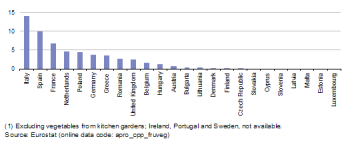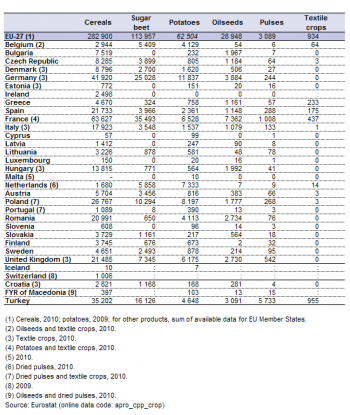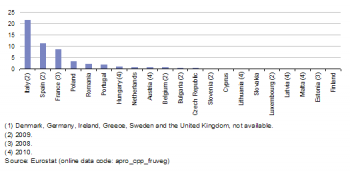Archive:Agricultural products
- Data from May 2014. Most recent data: Further Eurostat information, Main tables and Database. Planned article update: May 2015.

(2000=100) - Source: Eurostat (apro_cpp_crop)

(%, based on tonnes) - Source: Eurostat (apro_cpp_crop)

(million tonnes) - Source: Eurostat (apro_cpp_fruveg)

(1 000 tonnes) - Source: Eurostat (apro_mk_pobta), (apro_mk_cola) and (apro_mt_pann)
There is a wide diversity of natural environments, climates, economic conditions and farming practices across Europe. They are reflected in the broad array of food and drink products that are made available for human consumption and animal feed, as well as a range of inputs for non-food processes. Indeed, agricultural products contribute to the cultural identity of Europe’s people and regions.
With this in mind, European Union (EU) legislation has been developed to protect particular food and drink product names which are linked to a specific territory or a specific production method, aiming to provide guarantees as to the origin (demarcation) and authenticity of a range of products.
Main statistical findings
Crops
In 2012, the EU-28 produced 285 million tonnes of cereals (including rice). Despite the vagaries of the weather, cereal production in the EU-28 was relatively stable between 2002 and 2012 — generally not fluctuating by more than +/-12 % (see Figure 1) — albeit with notably higher harvests in 2004 and 2008 and a relatively low one in 2003. The production of cereals in the EU-28 fell from a high recorded in 2008 with production down by 6.0 % in 2009 and by a further 6.0 % in 2010; in 2011 production increased by 4.0 % before a further fall (-3.4 %) was recorded in 2012. The production of cereals within the EU-28 was just 3.4nbsp;% lower in 2012 than it had been in 2002.
Between 2002 and 2012 the output of potatoes followed a relatively similar development to that for cereals, with the notable exception of a contraction in potato production in 2008 contrasting with the strong growth for cereals in the same year. Production of potatoes was 24.8 % lower in 2012 than it had been in 2002. The production of sugar beet finished this 10-year period with a level of production that was 5.5 % lower in 2012 than it had been in 2002, despite relatively large increases recorded in 2004, 2009 and 2011 and decreases recorded in 2003, 2006 and 2008. Among the four crops shown in Figure 1, oilseeds recorded by far the strongest growth between 2002 and 2012, rising by 43.3 %. Much of this growth came in 2004, supplemented by a period of sustained growth in 2008 and 2009. By 2009, the level of oilseed production stood 54.5 % above its 2002 level, but dropped back after small contractions in output recorded for 2010 and 2011 and a somewhat larger contraction recorded for 2012.
Figure 2 presents an analysis of the production of cereals in the EU-28 in 2012. Almost half (47.1 %) of the total production of cereals was accounted for by wheat, while around one fifth of the total was composed of grain maize and corn-cob mix (21.0 %) and a further fifth of barley (19.3 %).
France and Germany were by far the largest cereal, sugar beet and oilseed producers, together accounting for just over a half (53.2 %) of the EU-28’s oilseeds production, more than half of its sugar beet production (53.5 %), and two fifths of its cereals production (40.0 %) in 2012 (see Table 1). The production of potatoes was more widely spread across the EU Member States, with Germany recording the highest level of production (almost 20 % of the EU-28 total), while Poland, the Netherlands and France each accounted for between 17 % and 11 %. France was, by far, the leading producer of pulses.
In the EU-28, the most important vegetables in terms of production were tomatoes, onions and carrots, while the most important fruits were oranges, apples and peaches. In 2012, Italy and Spain had the largest tomato production among the EU Member States, with a combined share that was equal to three fifths (61.1 %) of the EU-28’s production of 15.0 million tonnes. Turkey’s reported production of tomatoes was 11.4 million tonnes in 2012.
The cultivation of dessert apple trees was common across much of the EU, although the area of plantations in several eastern EU Member States was particularly high, notably in Poland, Romania, Hungary and the Czech Republic: together these four Member States accounted for more than half (52.2 %) of the area of dessert apple tree plantations in the EU-28 in 2012. With the exception of the United Kingdom, the other large EU Member States also reported large areas of dessert apple tree plantations, most notably Italy.
Meat and milk
Table 2 summarises a range of different agricultural products that are related to animals. Dairy production has a diverse structure across the EU Member States, in terms of farm and dairy herd sizes, as well as milk yields. The total collection of cows' milk in the EU-28 in 2012 amounted to an estimated 140 million tonnes. Figure 5 shows that just under one third (32.9 %) of the whole milk that was utilised in the EU-28 in 2012 was converted into cheese, with butter accounting for the next highest proportion (29.4 %); just over a tenth of the whole milk utilised in the EU-28 was used for drinking milk (13.3 %) and for cream (13.0 %). Germany and France recorded the highest amounts of cows’ milk collected in the EU-28 in 2012 and they also accounted for the highest levels of production for butter and cheese; together they contributed between 38 % and 46 % of the EU-28’s total production for each of these three dairy products.
The principal meat product in the EU-28 was pig meat (an estimated 22 million tonnes in 2012), with the weight of production almost three times as high as that for beef/veal (7.6 million tonnes); the production of sheep meat in the EU-28 was relatively modest (0.7 million tonnes).
A quarter (24.8 % or almost 5.5 million tonnes) of the EU-28’s pig meat production in 2012 came from Germany, the next highest contributions being recorded for Spain (15.8 %) and France (8.9 %), while the 7.7 % share for Poland and the 7.3 % share for Denmark were also notable. Just under one fifth (19.5 % or almost 1.5 million tonnes) of the beef/veal produced in the EU-28 originated from France in 2012, with Germany (15.0 %), Italy (12.9 %) and the United Kingdom (11.6 %) the next largest producers; Ireland reported a relatively high share (6.5 %) of the EU-28’s production of bovine meat. The United Kingdom dominated the production of sheep meat (almost 0.3 million tonnes), with a 39.0 % share of the EU-28 total in 2012, followed by Spain (17.3 %), France (11.7 %), Greece (9.8 %) and Ireland (7.6 %).
Data sources and availability
Annual statistics on the production of a range of specific crops are covered by Council Regulations, although the data presented for fresh fruit and vegetables are collected under various informal agreements with the EU Member States.
The statistics on crop production relate to harvested production. Agricultural production of crops is synonymous with harvested production and includes marketed quantities, as well as quantities consumed directly on the farm, losses and waste on the holding, and losses during transport, storage and packaging.
Statistics on milk, eggs and meat products are compiled according to Community legislation. Milk production covers farm production of milk from cows, sheep, goats and buffaloes. A distinction is made between milk collected by dairies and milk production on the farm. Milk collection is only a part of the total use of milk production on the farm, the remainder generally includes own consumption, direct sale, processing on farm and animal feed.
Meat production is based here on the activity of slaughterhouses regarding meat fit for human consumption. The carcass weight is the weight of the slaughtered animal’s cold body and the precise definition varies according to the animal under consideration.
Context
Information on agricultural products may be used to analyse developments within agricultural markets in order to help distinguish between cycles and changing production patterns; these statistics can also be used to study how markets respond to policy actions. Agricultural product data also provides supply side information, furthering understanding as regards price developments which are of particular interest to agricultural commodity traders and policy analysts.
In October 2007, the Council adopted legislation to establish a single common market organisation for agricultural products (Regulation 1234/2007). This was designed to reduce the volume of legislation in the farming sector, to improve legislative transparency, and to make agricultural policy more easily accessible. Between the start of 2008 and the start of 2009, the single common market organisation replaced 21 individual markets for a variety of different products such as fruit and vegetables, cereals, meats, eggs, dairy products, sugar or wine.
Widespread reforms of the common agricultural policy (CAP) took place in 2003, 2008 and 2013. The December 2013 reforms comprise four Regulations, including Regulation 1308/2013 which concerns measures linked to agricultural products.
See also
Further Eurostat information
Publications
- Agriculture, forestry and fishery statistics — 2013 edition
- Agriculture, fishery and forestry statistics — Main results — 2010–11 — 2012 edition
Main tables
- Agriculture (t_agri), see:
- Agricultural production (t_apro)
- Crops products (t_apro_cp)
- Poultry farming (t_apro_ec)
- Milk and milk products (t_apro_mk)
- Livestock and meat (t_apro_mt)
- Regional Agriculture Statistics (t_agr_r)
Database
- Agriculture (agri), see:
- Agricultural production (apro)
- Crops products (apro_cp)
- Poultry farming (apro_ec)
- Milk and milk products (apro_mk)
- Livestock and meat (apro_mt)
Dedicated section
Methodology / Metadata
- Crops products: areas and production (ESMS metadata file — apro_cpp_esms)
- Crops products: supply balance sheets (ESMS metadata file — apro_cpb_esms)
- Livestock and meat (ESMS metadata file — apro_mt_esms)
Source data for tables and figures (MS Excel)
Other information
- Crop statistics are governed by:
- Regulation 543/2009 concerning crop statistics;
- Regulation 837/90 on the statistical information to be supplied by the Member States on cereals production;
- Regulation 959/93 on statistical information on crop products other than cereals.
- Milk statistics are governed by:
- Directive 2003/107/EC of 5 December 2003 amending Council Directive 96/16/EC;
- Directive 96/16/EC of 19 March 1996 on statistical surveys of milk and milk products.
- Livestock and meat statistics are governed by:
- Regulation 1165/2008 of 19 November 2008 concerning livestock and meat statistics and repealing Council Directives 93/23/EEC, 93/24/EEC and 93/25/EEC.
External links
- European Commission — Agriculture and Rural Development — EU agricultural product quality policy
- European Commission — Agriculture and Rural Development — Simplification of the CAP


